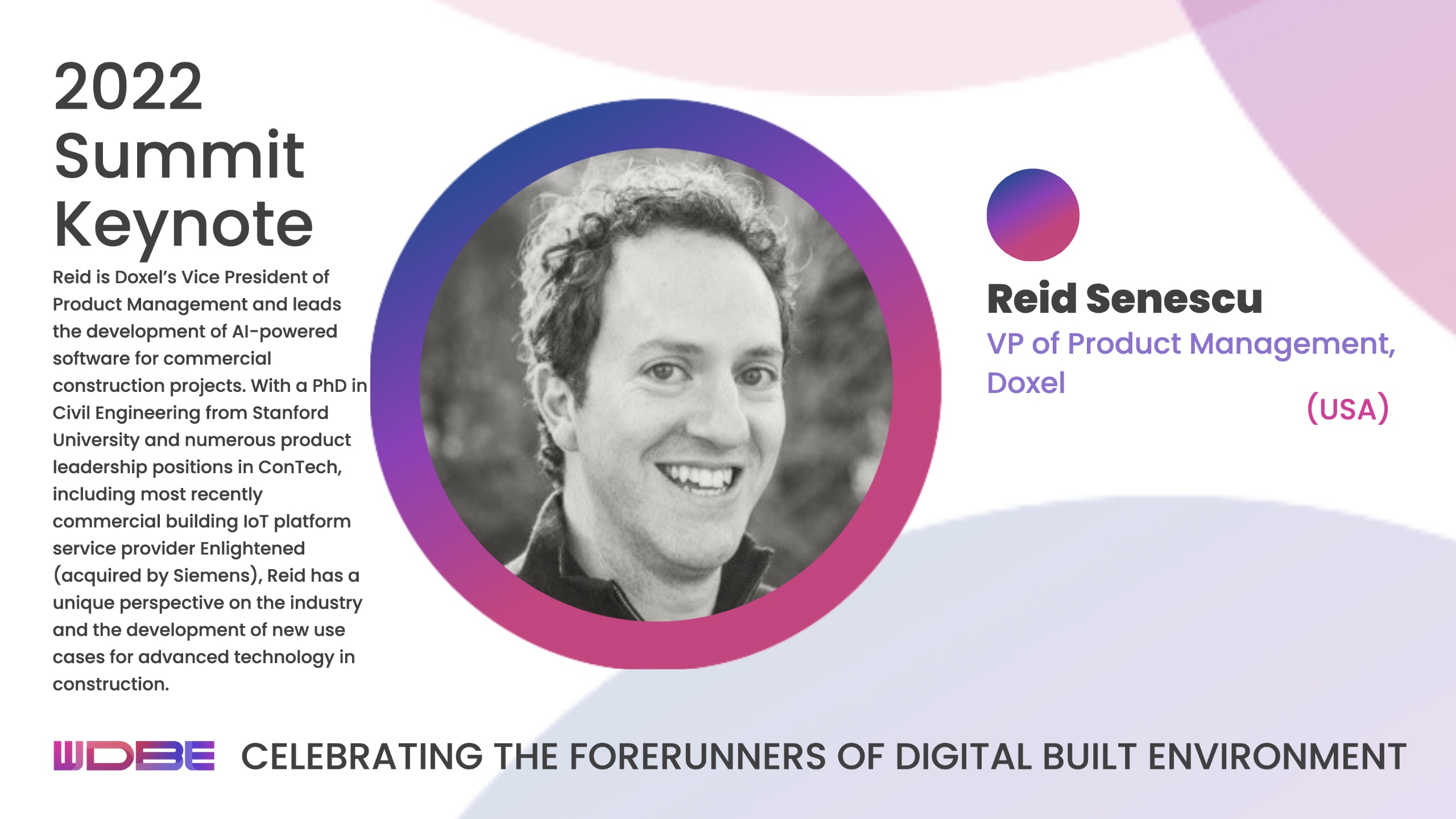I sat down with Reid Senescu, Vice President of Product Management at Doxel, an AI-powered construction tech company. We discussed his professional life, the use of AI and data in construction, and looked into the future.
Reid has a Ph.D. in Civil Engineering from Stanford University, and his work history includes companies like SOM, Arup, Rhumbix, and Enlighted. He’s also been a consultant and a startup founder. Reid is a keynote speaker at WDBE 2022 in September.
A career driven by cycles of interests
Looking back at his career, Reid has completed repeated cycles of seeking out the next big challenge in the industry and then figuring out how to solve it technologically.
As a kid in the Chicago area, Reid was surrounded by skyscrapers. They enthralled him so much that his first career choice was SOM, a design firm for some of the world’s tallest buildings.
While working in structural engineering, Reid realized that gravity is a pretty simple concept, whereas earthquakes pose complex challenges. As a result, he joined Arup, a company with top-notch earthquake design expertise.
Later, Reid became interested in the information technology aspect of the industry and saw new opportunities in mobile apps and smartphones. That led him to Rhumbix, a company that digitalizes construction field operations.
Turning data into insights
“Rhumbix was followed by IoT, and for me, the next big opportunity in our industry is taking all the learnings from various industries plus artificial intelligence and machine learning and applying them here in construction,” Reid explained.
Reid has spent considerable time evaluating AI companies in the construction technology space. He determined that Doxel was a company with a “data market fit” and a fabulous engineering team. The company’s repeat customers enjoyed the insights they got from the powerful data generated in every construction project.
It is not self-evident that talented developers would consider a construction software company their first employment choice. However, Reid noticed that his new company’s AI engineers were on a par with those of the Teslas, Googles, and Apples of the world. Furthermore, Doxel’s product engineering culture allowed them to bring products to market quickly.
Where to get the highest ROI
Reid had a definite answer to my question about where to get the highest ROI from construction tech. He noted that a construction site has many variables beyond a single company’s control. They range from the availability of materials or labor to the weather and other random factors. Trying to control them with technology is futile.
Instead, it makes sense to provide the on-site workers and managers with feedback loops that allow them to make better decisions. That leads to projects that are on time, on budget, safe to work on, and built as designed.
Reid does not support the top-down digitalization of construction sites: “If you don’t start with the craft worker, with the superintendent, and with the project manager in the field and make their lives easier, then that technology is not going to be adopted.”
Finding the recurring variables
Construction projects are, in some respects, unique, but they share many common and constantly recurring variables. For example, the way they use BIM is relatively uniform. Doxel spends much time ensuring that it understands what the common denominators are. Otherwise, it would be impossible to devise a single solution that every project could use.
Reid likens an AI company to an iceberg. Most development goes into internal tools under sea level. The software must rely on dynamic and variable data sets from various industry sectors: from oil and gas to data centers and healthcare facilities to residential projects. In other words, flexibility is a must if you want to succeed in this environment.
The nature of construction does not allow the creation of a 100% automated solution. Therefore, Doxel employs virtual design and construction engineers, who support a customer initially. From the customer’s perspective, setup just takes one or two short conversations
Looking into the future
Reid believes that technology can tackle the industry’s challenges, one of which is environmental sustainability; another is the shortage of skilled craft workers.
Urbanization is not stopping, which calls for faster building processes that provide higher quality. This will push design and construction limits and require new technological solutions.
“I think in the next ten years, we will continue on the BIM journey that we’ve been on for the last couple of decades. The data that we’ve been generating during the design stage will start to be more and more tied to the data that is being generated during construction today,” Reid concluded.
You can hear Reid’s keynote speech at WDBE on 29 September 2022. He’s going to talk about how AI supports lean construction work.
Register for the event at wdbe.org!
Listen to the whole interview on WDBE Talks.
View the original article and our Inspiration here


Leave a Reply